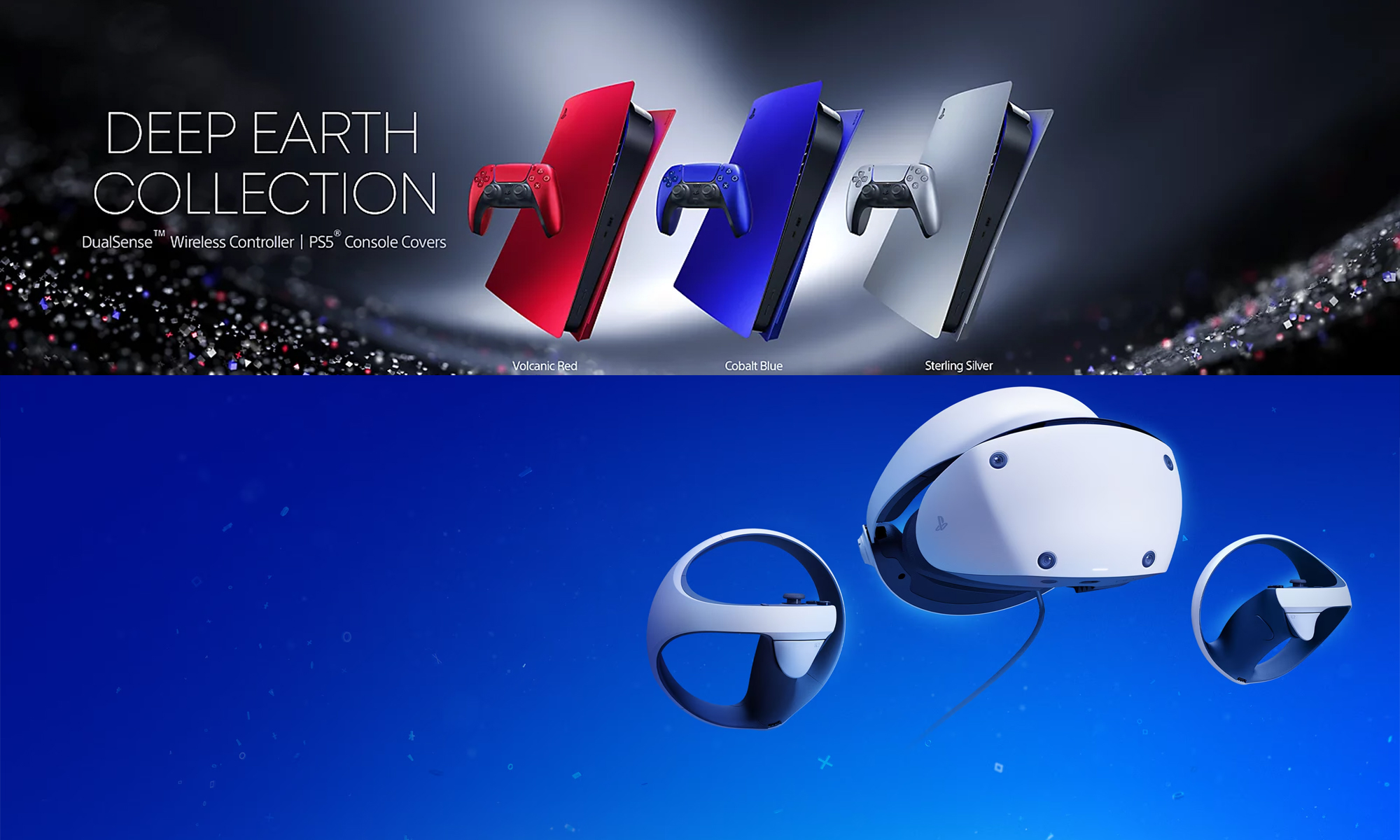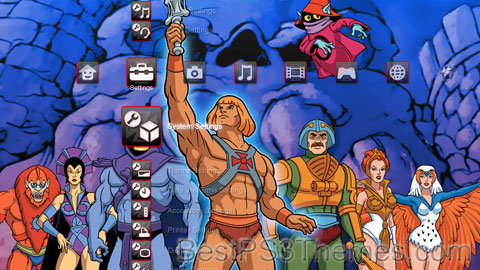Clone Wars theme by TriangleOffense
Download: CloneWars.p3t

The #1 spot for Playstation themes!
Devil May Cry 4 Best theme by Travis Kamiar
Download: DMC4Best.p3t

(8 backgrounds)
P3T Unpacker v0.12
Copyright (c) 2007. Anoop Menon
This program unpacks Playstation 3 Theme files (.p3t) so that you can touch-up an existing theme to your likings or use a certain wallpaper from it (as many themes have multiple). But remember, if you use content from another theme and release it, be sure to give credit!
Download for Windows: p3textractor.zip
Instructions:
Download p3textractor.zip from above. Extract the files to a folder with a program such as WinZip or WinRAR. Now there are multiple ways to extract the theme.
The first way is to simply open the p3t file with p3textractor.exe. If you don’t know how to do this, right click the p3t file and select Open With. Alternatively, open the p3t file and it will ask you to select a program to open with. Click Browse and find p3textractor.exe from where you previously extracted it to. It will open CMD and extract the theme to extracted.[filename]. After that, all you need to do for any future p3t files is open them and it will extract.
The second way is very simple. Just drag the p3t file to p3textractor.exe. It will open CMD and extract the theme to extracted.[filename].
For the third way, first put the p3t file you want to extract into the same folder as p3textractor.exe. Open CMD and browse to the folder with p3extractor.exe. Enter the following:
p3textractor filename.p3t [destination path]Replace filename with the name of the p3t file, and replace [destination path] with the name of the folder you want the files to be extracted to. A destination path is not required. By default it will extract to extracted.filename.
A-ROID theme by MADSN1PE
Download: A-ROID.p3t

(1 background)
P3T Unpacker v0.12
Copyright (c) 2007. Anoop Menon
This program unpacks Playstation 3 Theme files (.p3t) so that you can touch-up an existing theme to your likings or use a certain wallpaper from it (as many themes have multiple). But remember, if you use content from another theme and release it, be sure to give credit!
Download for Windows: p3textractor.zip
Instructions:
Download p3textractor.zip from above. Extract the files to a folder with a program such as WinZip or WinRAR. Now there are multiple ways to extract the theme.
The first way is to simply open the p3t file with p3textractor.exe. If you don’t know how to do this, right click the p3t file and select Open With. Alternatively, open the p3t file and it will ask you to select a program to open with. Click Browse and find p3textractor.exe from where you previously extracted it to. It will open CMD and extract the theme to extracted.[filename]. After that, all you need to do for any future p3t files is open them and it will extract.
The second way is very simple. Just drag the p3t file to p3textractor.exe. It will open CMD and extract the theme to extracted.[filename].
For the third way, first put the p3t file you want to extract into the same folder as p3textractor.exe. Open CMD and browse to the folder with p3extractor.exe. Enter the following:
p3textractor filename.p3t [destination path]Replace filename with the name of the p3t file, and replace [destination path] with the name of the folder you want the files to be extracted to. A destination path is not required. By default it will extract to extracted.filename.
Soulja Slim (Slim504) theme by MADSN1PE
Download: SouljaSlim.p3t

(1 background)
P3T Unpacker v0.12
Copyright (c) 2007. Anoop Menon
This program unpacks Playstation 3 Theme files (.p3t) so that you can touch-up an existing theme to your likings or use a certain wallpaper from it (as many themes have multiple). But remember, if you use content from another theme and release it, be sure to give credit!
Download for Windows: p3textractor.zip
Instructions:
Download p3textractor.zip from above. Extract the files to a folder with a program such as WinZip or WinRAR. Now there are multiple ways to extract the theme.
The first way is to simply open the p3t file with p3textractor.exe. If you don’t know how to do this, right click the p3t file and select Open With. Alternatively, open the p3t file and it will ask you to select a program to open with. Click Browse and find p3textractor.exe from where you previously extracted it to. It will open CMD and extract the theme to extracted.[filename]. After that, all you need to do for any future p3t files is open them and it will extract.
The second way is very simple. Just drag the p3t file to p3textractor.exe. It will open CMD and extract the theme to extracted.[filename].
For the third way, first put the p3t file you want to extract into the same folder as p3textractor.exe. Open CMD and browse to the folder with p3extractor.exe. Enter the following:
p3textractor filename.p3t [destination path]Replace filename with the name of the p3t file, and replace [destination path] with the name of the folder you want the files to be extracted to. A destination path is not required. By default it will extract to extracted.filename.
SOCOM Confrontation theme by Dennis “F-Rott” Ferrand
Download: SOCOMConfrontation_5.p3t
Alienware PS3 theme by Rattus
Download: AlienwarePS3_2.p3t

(4 backgrounds)
P3T Unpacker v0.12
Copyright (c) 2007. Anoop Menon
This program unpacks Playstation 3 Theme files (.p3t) so that you can touch-up an existing theme to your likings or use a certain wallpaper from it (as many themes have multiple). But remember, if you use content from another theme and release it, be sure to give credit!
Download for Windows: p3textractor.zip
Instructions:
Download p3textractor.zip from above. Extract the files to a folder with a program such as WinZip or WinRAR. Now there are multiple ways to extract the theme.
The first way is to simply open the p3t file with p3textractor.exe. If you don’t know how to do this, right click the p3t file and select Open With. Alternatively, open the p3t file and it will ask you to select a program to open with. Click Browse and find p3textractor.exe from where you previously extracted it to. It will open CMD and extract the theme to extracted.[filename]. After that, all you need to do for any future p3t files is open them and it will extract.
The second way is very simple. Just drag the p3t file to p3textractor.exe. It will open CMD and extract the theme to extracted.[filename].
For the third way, first put the p3t file you want to extract into the same folder as p3textractor.exe. Open CMD and browse to the folder with p3extractor.exe. Enter the following:
p3textractor filename.p3t [destination path]Replace filename with the name of the p3t file, and replace [destination path] with the name of the folder you want the files to be extracted to. A destination path is not required. By default it will extract to extracted.filename.
Little Big PS3 Ver. 2.0 theme by HikariNoSenshi
Download: LittleBigPS3v2.p3t
Masters of the Universe theme by ccook
Download: MastersoftheUniverse.p3t

(1 background)
This article may be too long to read and navigate comfortably. When this tag was added, its readable prose size was 17,000 words. (February 2019) |
Masters of the Universe (sometimes referred to as the He-Man or She-Ra series) is a sword and planet-themed media franchise created by Mattel.[1] The main premise revolves around the conflict between He-Man (the alter ego of Prince Adam) and Skeletor on the planet Eternia, with a vast lineup of supporting characters in a hybrid setting of medieval sword and sorcery, and sci-fi technology. A follow-up series, She-Ra: Princess of Power revolves around He-Man's sister She-Ra and her rebellion against The Horde on the planet Etheria.[2] Since its initial launch, the franchise has spawned a variety of products, including multiple lines of action figures, six animated television series, several comic series, video games, books and magazines, a daily newspaper comic strip, and two feature films (one animated, one live action).[3]
He-Man and the accompanying Masters of the Universe franchise would make their debut in 1982 with Mattel's release of the original "Masters of the Universe" 5.5-inch action-figure toy line. Masters of the Universe, often abbreviated as MOTU, would begin its mythos through the minicomics that accompanied the toys throughout the 1980s. These initial mini comics were soon followed by several children's books and issues of DC Comics. However, the Masters of the Universe franchise would become best known through Filmation's groundbreaking He-Man and the Masters of the Universe animated series.[4] Debuting in the fall of 1983, the Filmation series ran 130 episodes over two seasons until November 1985.[5]
Since its inception, Masters of the Universe has usually placed its focus on the two primary characters, the blond muscular He-Man, "the most powerful man in the Universe," and his nemesis, the evil skull-faced, blue-skinned sorcerer Skeletor and their many moral-themed encounters on the planet Eternia.[6][7][8] Set in a hybrid world of sword and sorcery and technological sci-fi, He-Man battles with Skeletor to prevent him from conquering Eternia and discovering the secrets of Castle Grayskull—a mysterious ancient fortress with a skull-shaped facade, containing great power and magic.[9] As with many toy franchises that have been transferred to several different media, there are a number of story differences between the various versions of Masters of the Universe. In most continuities from the Filmation series onward, He-Man is the secret identity of Prince Adam, the son of King Randor and Queen Marlena, the ruling royal family of Eternia.[10][11] Adam becomes He-Man by holding aloft his magic Power Sword and uttering the words "By the power of Grayskull…" and serves as the protector of good on Eternia.[12] He is first given this ability by the Sorceress of Castle Grayskull, a powerful magic user and mystic guardian of the castle, who in many depictions is able to transform herself into the falcon Zoar.[13][14] Upon Adam's transformation into He-Man, his cowardly green pet tiger Cringer becomes the mighty Battle Cat, a giant armored feline that He-Man often rides into battle.[15]
He-Man's most prominent allies include Man-At-Arms,[16] a wise loyal veteran soldier and inventor; and his adopted daughter Teela, a spirited and skillful female warrior, often portrayed as captain of the Eternian Royal Guard and a potential love interest of He-Man/Prince Adam.[17] The childlike Trollan magician Orko also often features as one of He-Man's closest allies;[18] as does Stratos, a flying bird-man from the kingdom of Avion;[19] Ram-Man, a stout dimwitted warrior with springlike legs and a large helmet that encloses his head and upper torso;[20] and Man-E-Faces, an actor with face-changing abilities.[21]
Skeletor is originally described as an evil being from another dimension and in some later MOTU lore as a disfigured and vengeful relative of the royal family, known as Keldor.[22][23] From his lair on Snake Mountain, Skeletor would assemble his "Evil Warriors" to assist in his various schemes to conquer Eternia. These core minions usually include Beast Man, an orange-furred, apelike master of beasts;[24] Mer-Man, an aquatic fishlike ocean warlord;[25] Evil-Lyn, a powerful sorceress and one of Skeletor's most feared and competent associates;[26] Trap Jaw, an iron-jawed criminal with a mechanical arm that can be fitted by a various assortment of weapons;[27] and Tri-Klops, a mercenary swordsman with a rotating three-eyed visor.[28]
The series overall would feature a wide and ever-expanding cast of heroic and villainous characters added to the toy line, the Filmation cartoon, and other media; with the franchise far outshining prior expectations, continuing to grow through 1983 and 1984.[4] The release of the animated cartoon movie He-Man and She-Ra: The Secret of the Sword in the spring of 1985 introduced He-Man's twin sister She-Ra (with her secret alter ego Princess Adora)[29] and the arch-villain Hordak (leader of the Evil Horde and the former master of Skeletor) on the planet Etheria.[30] Stemming from the animated movie, Filmation went on to produce 93 episodes of the series She-Ra: Princess of Power, which ran until the end of 1987, along with the He-Man & She-Ra: Christmas Special.[31] Other main characters of the She-Ra series would include Swift Wind, winged unicorn and alter ego of She-Ra's trusty steed Spirit;[32] Light Hope, mystical living beam of light and mentor to She-Ra;[33] and her Great Rebellion allies Glimmer, magically inclined onetime leader of the rebellion;[34] Bow, skilled archer and the main male protagonist of the series;[35] Kowl, Bow's owllike, rainbow-eared companion;[36] Madame Razz, absent-minded witch with her sarcastic sentient Broom;[37][38] and Queen Angella, Glimmer's mother and angel-winged queen of the Bright Moon;[39] along with Hordak's spell-casting witch Shadow Weaver;[40] shape-shifting spy Imp;[41] bumbling bug-eyed henchman Mantenna;[42] Force Squad captain Catra;[43] evil scientist Modulok;[44] beastly warrior Grizzlor;[45] energy-draining Leech;[46] and thuggish henchwoman Scorpia.[47]
Various children's books, magazines, comics, read-along records/cassette tapes, and other merchandise were also released worldwide around this time, with much of the content based primarily on the Filmation He-Man and She-Ra series. The live-action film Masters of the Universe was released in 1987 by Cannon Films, starring Dolph Lundgren and Frank Langella.[48] The later 1980s mini comics, Marvel comics series, and UK magazine comics continued the adventures of He-Man and She-Ra past the end of the two Filmation series.[49][50][51] However, popularity had waned by the end of 1987 and a planned continuation of the original toy line under the heading of "The Powers of Grayskull" (set in ancient Eternia, featuring the villain King Hiss and He-Man's ancestor He-Ro) was started, but eventually scrapped.[52][53]
He-Man would be brought back in 1989 in an entirely new and space-based cartoon series and toy line known as "The New Adventures of He-Man." Only He-Man and Skeletor would return as major characters to join the battle between Galactic Guardians and Space Mutants on the planet Primus. Jetlag Productions would go on to produce 65 episodes of the New Adventures cartoon, with a few mini comics and adventure magazines also created for this new series. Ultimately, though, the series would not be as successful and the entire franchise would go on a hiatus for more than a decade.[54]
After some success with a "Commemorative Series" rerelease of the classic action figures in 2000, Mattel relaunched the toy line with all-new action figures, playsets, and vehicles, sculpted by Four Horsemen Studios in 2002.[55][56] As part of the relaunch, a modern updated animated series was also created by Mike Young Productions, lasting for 39 episodes; featuring He-Man and his ensemble of heroic warriors, now called the "Masters of the Universe," battling Skeletor's minions and, later, King Hiss, the ancient and evil lord of the Snake Men.[52] Characters such as Mekaneck, heroic warrior with a mechanical extending neck;[57] Buzz-Off, heroic beelike flying Andreenid warrior;[58] Clawful, large villainous crab-like henchman;[59] Whiplash, evil reptilian Caligar with a deadly tail; Stinkor, foul-smelling mutated Paleezean; and many others would gain more prominent backstories during this series.[60] Several volumes of comic books were also produced to go along with the series by Image Comics and MVCreations. Although popular with longtime fans and collectors (with mini-statue figures being released by NECA until 2007), the new series failed to catch on with a larger audience and was canceled in 2004.[61]
From 2008 to 2020, a new assortment of Masters of the Universe action figures has been released under the banner of "Masters of the Universe Classics." Primarily geared toward the collector's market, the series made up an entirely new story in "Classics bios" and used various elements from previous Masters of the Universe lore, many times changing those elements to suit the new story, with characters from all previous incarnations (and also featured a continuation of the original mini comics line). DC Comics would soon follow suit and relaunch a new grittier, contemporary version of the Masters of the Universe franchise, releasing various new comic book series from 2012 until 2020; featuring crossovers with the DC Comics Universe, ThunderCats, and a new origin for She-Ra, culminating in Hordak's conquest of Eternia.[62]
In 2020, Mattel released a new line of 5.5" scale action figures, vehicles and playsets under the Masters of the Universe Origins line.[63]
Netflix and DreamWorks released an animated series entitled She-Ra and the Princesses of Power in 2018, which released five seasons until 2020. This was followed in 2021 by Masters of the Universe Revelation, a new Netflix animated series produced by Kevin Smith.[64]
Mattel began development of He-Man and the Masters of the Universe in the late 1970s with Conan the Barbarian–inspired concepts from Roger Sweet, Mark Taylor, Donald F. Glut, and several other contributors.[4] The catalyst for the creation of He-Man began in 1976, when Mattel's CEO Ray Wagner declined a request to produce a toy line of action figures based on the characters from the George Lucas film Star Wars, with the film's toy rights being acquired by Kenner instead.[65][66][note 1] Upon the commercial success of the film trilogy and all related merchandise during the next few years, Mattel attempted to launch several unsuccessful toy lines, none of which captured the public's imagination or made a significant dent in the toy market.[65][note 2]
In the race to design the next hit action figure, Roger Sweet, a lead designer working for Mattel's Preliminary Design Department throughout much of the 1970s and 1980s, according to his book Mastering the Universe: He-Man and the Rise and Fall of a Billion-Dollar Idea, was the first to conceptualize the idea of He-Man.[65][66] However, this is not officially acknowledged by Mattel, and authorship of the He-Man character has been subject to debate.[67][68][note 3] According to various former Mattel designers, Roger Sweet drew inspiration for the designs of his first He-Man prototypes from fantasy drawings of Mattel packaging designer Mark Taylor, which included a drawing of a He-Man-like character called Torak.[4][69][70]
Roger Sweet presented the He-Man concept to Ray Wagner at the Mattel Product Conference, in the form of three large three-dimensional plaster prototype models, which Sweet dubbed the "He-Man Trio." These prototypes were molded from extensively modified Big Jim action figures (Battle Cat would also be adapted from a tiger in the Big Jim toy line).[71][72] The He-Man Trio models were an axe-wielding barbarian, a tank-headed soldier, and a spaceman with a Boba Fett–like helmet.[65] Out of the three concepts, the barbarian version of He-Man was chosen to be the basis of the toy line (this original trio-prototype idea was released around 30 years later as the figure Vykron, and the barbarian concept on its own as Vikor, in the "Masters of the Universe Classics" line).[73]
"The only way I was going to have a chance to sell this [to Wagner] was to make three 3D models—big ones. I glued a Big Jim figure [from another Mattel toy line] into a battle action pose and I added a lot of clay to his body. I then had plaster casts made. These three prototypes, which I presented in late 1980, brought He-Man into existence. I simply explained that this was a powerful figure that could be taken anywhere and dropped into any context because he had a generic name: He-Man!"[note 4][65]
—Roger Sweet[66]
Originally set under the working title "Lords of Power," the name "Masters of the Universe" came into being when it was suggested that the former name of the toy line was too religious in nature.[74] The roster of characters would soon expand past the main hero, He-Man, and Mark Taylor would draw inspiration for the series main villain, Skeletor, from his 1971 sketch entitled The King of Styx, along with early renderings of his characters Demo-Man and D-Man.[7] Taylor would create preliminary designs for several other original characters as well, with additional ideas or direction from Mark Ellis and Paul Cleveland, among others, but the premise behind the toy line had not yet been fully established.[4][75] The backstory of He-Man was first conceptualized for special mini-comic books that Mattel marketing director Mark Ellis promised distributors would accompany the toys.[71] Mattel had DC Comics mock up a comic book, with the earliest storybooks written by Donald F. Glut.[76][77][78] With major distributor Toys "R" Us concerned that "five-year-olds don't read", Mark Ellis then first proposed the idea of an animated TV special. This would eventually lead to a meeting with Filmation head Lou Scheimer and the creation of the He-Man and the Masters of the Universe animated series.[71]
Earlier in 1980, the rights-holders of Conan the Barbarian had been negotiating the character's toy rights with Mattel and they entered into an agreement the following year regarding characters from the 1982 Conan movie. However, with Mattel introducing the Masters of the Universe toy line in 1982, the rights-holders sued Mattel claiming the character was an infringement on the character of Conan.[79] Mattel eventually won the lawsuit and after legal agreements were dissolved, it was stated that the toy line was never intended for the Conan film.[80][81] However, some Conan influence can be seen, as Roger Sweet has claimed to have drawn some inspiration from the paintings of Frank Frazetta, a fantasy artist with many works depicting Conan the Barbarian, when creating He-Man.[66]
The "Masters of the Universe" toy line was created by Mattel in 1981, and first released to stores in 1982 as 5½-inch action figures (as opposed to the 3¾-inch size used by Kenner's Star Wars and Hasbro's G.I. Joe: A Real American Hero lines).[4] The two main characters, He-Man ("the most powerful man in the universe")[82] and his arch-enemy Skeletor ("evil lord of destruction")[83] were the first released in action figure form, along with other core characters of the series: Man-At-Arms ("heroic master of weapons"), Beast Man ("Skeletor's savage henchman"), and Battle Cat ("He-Man's fighting tiger").[84][85][86]
Later on that year, the first wave of action figures in 1982 would also include Teela ("heroic warrior goddess"), Mer-Man ("evil ocean warlord"), Stratos ("heroic winged warrior"), and Zodac ("the cosmic enforcer").[87][88][89][90] The Teela action figure was originally proposed as representing both the Sorceress character (when wearing the figure's "snake armor") and the Teela character (when without the "snake armor"), as Mattel believed there would not be enough demand for two female action figures in the initial wave.[17] Alongside the first wave of figures were the Battle Ram ("mobile launcher") and Wind Raider ("assault lander") vehicles and the playset Castle Grayskull ("fortress of power and mystery").[91]
Christina Aguilera theme by d4v1e-g-unit
Download: ChristinaAguilera_4.p3t

(7 backgrounds)
Christina Aguilera | |
|---|---|
 Aguilera in 2023 | |
| Born | Christina María Aguilera December 18, 1980 New York City, US |
| Other names |
|
| Occupations |
|
| Years active | 1993–present |
| Organization | |
| Works | |
| Spouse |
Jordan Bratman
(m. 2005; div. 2011) |
| Partner | Matthew Rutler (eng. 2014) |
| Children | 2 |
| Awards | Full list |
| Musical career | |
| Genres | |
| Instruments | Vocals |
| Labels | |
| Website | christinaaguilera |
| Signature | |
 | |
Christina María Aguilera (/ˌæɡɪˈlɛərə/ AG-il-AIR-ə, Spanish: [kɾisˈtina maˈɾi.a aɣiˈleɾa];[1] born December 18, 1980) is an American singer, songwriter, actress, and television personality. Referred to as the "Voice of a Generation", she is noted for her four-octave vocal range, musical reinventions, sustaining high notes including use of the whistle register, and a signature use of melisma throughout her music. Recognized as an influential figure in popular music, she also became known for incorporating controversial themes such as feminism, sexuality, LGBT culture and the sex-positive movement into her work. Aguilera was also honoured as a Disney Legend, for her contributions to The Walt Disney Company.
After appearing on The All-New Mickey Mouse Club (1993–1994) as a child, Aguilera recorded "Reflection", the theme for the 1998 animated film Mulan and signed a record deal with RCA Records. She rose to fame in 1999 with her self-titled debut album and the US Billboard Hot 100 number-one singles, "Genie in a Bottle", "What a Girl Wants" and "Come On Over Baby (All I Want Is You)". Aguilera also won the Grammy Award for Best New Artist and followed with Mi Reflejo (2000) and My Kind of Christmas (2000); with the former becoming the best-selling Latin pop album of 2000. After gaining more control over her career, Aguilera sought a departure from her teen idol image and released Stripped (2002), which initially had a mixed response. The album later became one of the best-selling albums of the 21st century. Aguilera underwent another reinvention with the release of the critically praised old-school-music inspired Back to Basics (2006). Throughout these periods, she amassed numerous international successes, including the number-one single "Lady Marmalade", alongside "Beautiful", "Dirrty", "Can't Hold Us Down", "Fighter", "Ain't No Other Man" and "Hurt".
Throughout the early 2010s, Aguilera had a moderately successful period with the albums Bionic (2010) and Lotus (2012), with their respective lead singles, "Not Myself Tonight" and "Your Body", topping the US Dance Club Songs chart. She also starred in the 2010 film Burlesque and contributed to its soundtrack, earning a Golden Globe Award nomination. Aguilera returned to the top of the charts with a string of collaborations, including "Feel This Moment", "Say Something", and "Moves like Jagger"; with the latter reaching number-one on the Hot 100, making Aguilera one of the few artists to reach the top spot over three decades. She found critical success with her follow-up albums Liberation (2018) and Aguilera (2022). Her concurrent ventures included a role in the series Nashville (2015), roles in the films The Emoji Movie (2017) and Zoe (2018), becoming an ambassador for the World Food Programme (WFP), performing two concert residencies, co-founding the company Playground, and serving as a coach on the reality competition show The Voice (2011–2016).
Aguilera is one of the best-selling music artists of all time, with estimated sales of over 90 million records sold worldwide.[2] Considered a pop culture icon and a triple threat entertainer, she has been named one of the greatest vocalists of all time by publications such as Rolling Stone and Consequence of Sound and has been hailed as one of the most successful artists to come out of the 2000s. In 2009, Billboard named her the twentieth most successful artist of the decade, and was ranked eighth on VH1's list of greatest women in music. Aguilera has since been regarded as one of the most influential Latin artists in the entertainment industry, having helped shape the "Latin explosion" in the music industry. Her accolades include five Grammy Awards, two Latin Grammy Awards, six ALMA Awards, two MTV Video Music Awards (VMA), one Billboard Music Award, one Guinness World Record, and a star on the Hollywood Walk of Fame.
Christina María Aguilera was born on December 18, 1980, in New York City, to Shelly Loraine (née Fidler) and Fausto Wagner Xavier Aguilera.[3] Her father is an Ecuadorian emigrant from Guayaquil while her mother has German, Irish, Welsh, and Dutch ancestry.[4][5] Fausto Aguilera was a United States Army sergeant, and Shelly Loraine was a violinist in the American Youth Symphony before becoming a Spanish translator.[6][7]
Due to Fausto's military service, Aguilera's family moved frequently, living in New Jersey and Texas.[8] In 1983, they moved to Japan and lived in Sagamihara for at least two years.[9] During her youth in Pittsburgh metropolitan area, Aguilera attended North Allegheny Intermediate High School before leaving there to be homeschooled to avoid bullying she experienced at school.[10][11]
In 1986, the family returned to the United States, and settled in Pennsylvania, where they welcomed her younger sister, Rachel, in 1986.[12] Aguilera has spoken out about her father's physically and emotionally abusive behavior.[13] She noted that this is what made her turn to music, noting that, "growing up in an unstable environment and whatnot, music was my only real escape".[14] In 1987, Shelly filed to divorce Fausto and moved with Aguilera and Rachel to her mother's home in Rochester, a suburb of Pittsburgh.[15] She later married James Kearns with whom she had a son named Michael.[16] In 2012, following decades of estrangement, Aguilera expressed interest in reconciling with her biological father.[17]
Aguilera moving to her grandmother's home allowed her to explore her grandmother's records, which featured mostly soul and blues singers and increased her interest in music.[18] She also began to practice singing in public and competing in talent contests.[19] Following numerous contests, she earned reputation in her neighborhood as the "little girl with a big voice" and received widespread attention from local television and radio programs.[20][21]
In 1990, she performed the popular song "A Sunday Kind of Love" on the reality competition show Star Search, but was eliminated during the semi-final round.[22] Aguilera was eventually invited to sing "The Star-Spangled Banner" before Pittsburgh Penguins hockey, Pittsburgh Steelers football, and Pittsburgh Pirates baseball games, and at the 1992 Stanley Cup Finals.[23][24]
In 1991, Aguilera auditioned for a position on The All-New Mickey Mouse Club (MMC), aired on the Disney Channel. She ran against 400 candidates, and while she made the shortlist she was ultimately rejected for not meeting the minimum age requirement.[25] One year later, in 1992, Aguilera received a call from one of the show's producers asking if she was still interested in becoming a "Mouseketeer". She once again competed for a spot (this time, against 15,000 candidates) and was selected to join the variety program the following year.[26] Her fellow cast members included Ryan Gosling, Keri Russell, Britney Spears, and Justin Timberlake.[27] During the show recordings—which included Aguilera performing musical numbers and comedy sketches—she moved with her family to Orlando, Florida.[28] In 1994, it was reported the series would not return for a new season.[29]
Aiming to begin a music career, Aguilera moved to Japan in 1997. She was selected to record a duet with Japanese singer Keizo Nakanishi, with whom she performed in concert shows around the country.[30] Their song, "All I Wanna Do", was released as a single but failed to reach commercial success.[20] In June 1997, Aguilera went on to Romania to represent the United States in a singers contest during the Golden Stag Festival, but she failed to win over the audience.[31]
Seeking a recording contract, Aguilera recorded numerous demo tapes directed to record labels, including Walt Disney Records, for which she sent a cover of "Run to You" by Whitney Houston.[32] She eventually was chosen to record "Reflection", the theme song from the animated film Mulan (1998), which reached number 15 on the Billboard Adult Contemporary chart.[33] Following the attention she received with "Reflection", Aguilera caught the ear of Ron Fair, the A&R executive from RCA Records, who consequently signed Aguilera to the label.[8] In late 1998, she began to record her debut studio album into which producers reportedly invested over $1 million worth of writers, producers and vocal lessons.[8]
In May 1999, Aguilera released "Genie in a Bottle", the lead single off her long-awaited debut album, which topped the Billboard Hot 100 for five consecutive weeks and became the second best-selling single of 1999.[34] The song became an international success, increasing Aguilera's popularity worldwide, topping the charts in over 20 countries.[35] The single also attracted the attention of conservatives including celebrities such as Debbie Gibson that spoke out against its lyrical content, and was eventually considered "too provocative" to be sung by a teen idol.[36][37] Due to the criticism, Radio Disney replaced the song with a censored version.[38] The song was nominated for a Grammy Award for Best Female Pop Vocal Performance.[39]
Aguilera's self-titled debut album, Christina Aguilera, was released on August 24, 1999, to critical praise, debuting at number one on the Billboard 200.[40] It catapulted Aguilera into fame globally and sold over ten million copies in its first year.[41] It was later certified eight times platinum by the Recording Industry Association of America (RIAA),[42] and it has sold over 17 million copies worldwide.[43][44] Originally, Aguilera's desire was to create material directly inspired by R&B and soul, but the label opted for a more teen pop production due the genre's high financial return in the late 1990s.[45] At the 42nd Annual Grammy Awards, Aguilera won the Best New Artist category for which Time credited the award for "[helping] certify her credentials as a real singer".[46]
I was completely blown away, shocked, overwhelmed and thrilled. I didn't expect it. I've dreamed of that since I was eight years old. I was rambling off the top of my head, my knees were shaking and I'm still floating on air because of it!
—Aguilera on winning Best New Artist at the 42nd Annual Grammy Awards.[47]
After the album's release, "What a Girl Wants", topped the Hot 100 and is recognised as the first new number one entry on the chart for the 2000's decade.[48] The song was also nominated for Best Female Pop Vocal Performance at the 43rd Annual Grammy Awards.[48] This was followed with "I Turn to You" which reached number three there,[40] and "Come On Over Baby (All I Want Is You)" which became Aguilera's third number one song and achieved worldwide success.[49] She also released a cover of "The Christmas Song" in November 1999 which peaked at number 18 and became the second highest charting position of the song after the original in 1944.[50]
In May 2000, Aguilera embarked on her debut concert tour, Christina Aguilera in Concert, which toured North America, Latin America, Europe, and Japan until February 2001.[51][52] Her success continued to rise with the release of her second studio album, Mi Reflejo, in September 2000 which topped both the Billboard Top Latin Albums and Latin Pop Albums for nineteen consecutive weeks.[53] The album featured Spanish-language versions of several songs from her debut album along with new songs, and had Latin pop themes.[54] Three singles were release for the album including the Spanish version of "Come On Over Baby (All I Want Is You)" titled "Ven Conmigo (Solamente Tú)", "Pero Me Acuerdo de Ti" and "Falsas Esperanzas".[55] The latter two were performed at the 43rd Annual Grammy Awards.[56] The album went on to be the best-selling Latin pop album of 2000 and was later certified six times Latin platinum by the RIAA.[28][57] Mi Reflejo also reached the platinum stats in Argentina, Mexico, and Spain.[58] At the 2nd Annual Latin Grammy Awards, the album won Best Female Pop Vocal Album.[59]
In October 2000, Aguilera also released her third studio album, My Kind of Christmas, her first Christmas album, which reached number one on the US Top Holiday Albums chart.[60][61] The album received generally polarized reviews at the time but has since gone on to retrospectively receive praise.[62] Aguilera starred in a holiday special, My Reflection, which aired on December 3, 2000, on ABC.[63] Aguilera's commercial success saw her being named the 2000 Top Female Pop Act by Billboard.[64] The same year, she also filed a fiduciary duty against manager Steve Kurtz for "improper, undue, and inappropriate influence over her professional activities".[65] She eventually hired Irving Azoff to manage her career, aiming for control of her career and image.[65]
On January 16, 2001, Aguilera featured on Ricky Martin's "Nobody Wants to Be Lonely", which topped charts internationally and peaked at number 13 on the Hot 100, becoming her fifth top-20 hit in the US.[66][67] The song was ranked at number 65 on VH1's "100 Greatest Love Songs",[68] and was nominated for Best Pop Collaboration with Vocals at the 44th Annual Grammy Awards.[69] In April of that year, Aguilera featured alongside Lil' Kim, Mýa, and Pink on "Lady Marmalade" from the soundtrack for the film, Moulin Rouge! (2001).[70] The song received positive reviews and topped the Hot 100 for five consecutive weeks, becoming Aguilera's fourth number one.[71][72] The song also won the Grammy Award for Best Pop Collaboration with Vocals and the MTV Video Music Award for Video of the Year.[73]
In August 2001, Warlock Records released Just Be Free, a demo album recorded by Aguilera between 1994 and 1995 while she was looking for a recording deal following the end of The All-New Mickey Mouse Club (MMC).[74] She filed a suit against the label and the album's producers aiming to stop the release of the album; however, both parties came to a confidential settlement to release the album, in which Aguilera lent out her name, likeness, and image for an unspecified amount of damages.[75]
With a new management, Aguilera started moving away from her teen pop niche and began working on a new project.[76] She cultivated a new image by adopting the alter ego Xtina, dyeing her hair black, and sporting several tattoos and body piercings.[77] Aguilera's new persona was widely criticized by media outlets.[78][79][80] In September 2002, she released the controversial song, "Dirrty", which garnered mixed reviews and peaked as number 48 on Billboard Hot 100.[45] The song's accompanying music video generated controversy for depicting overtly sexual fetishes,[81] and attracted the attention of conservative organizations and moralists who sought to have the video banned on MTV.[82] The video also sparked protests in Thailand and was eventually banned on the country's local television.[83][84] "Dirrty" topped the charts in the UK and Ireland,[85] and has gone on to become a cult classic.[86]
